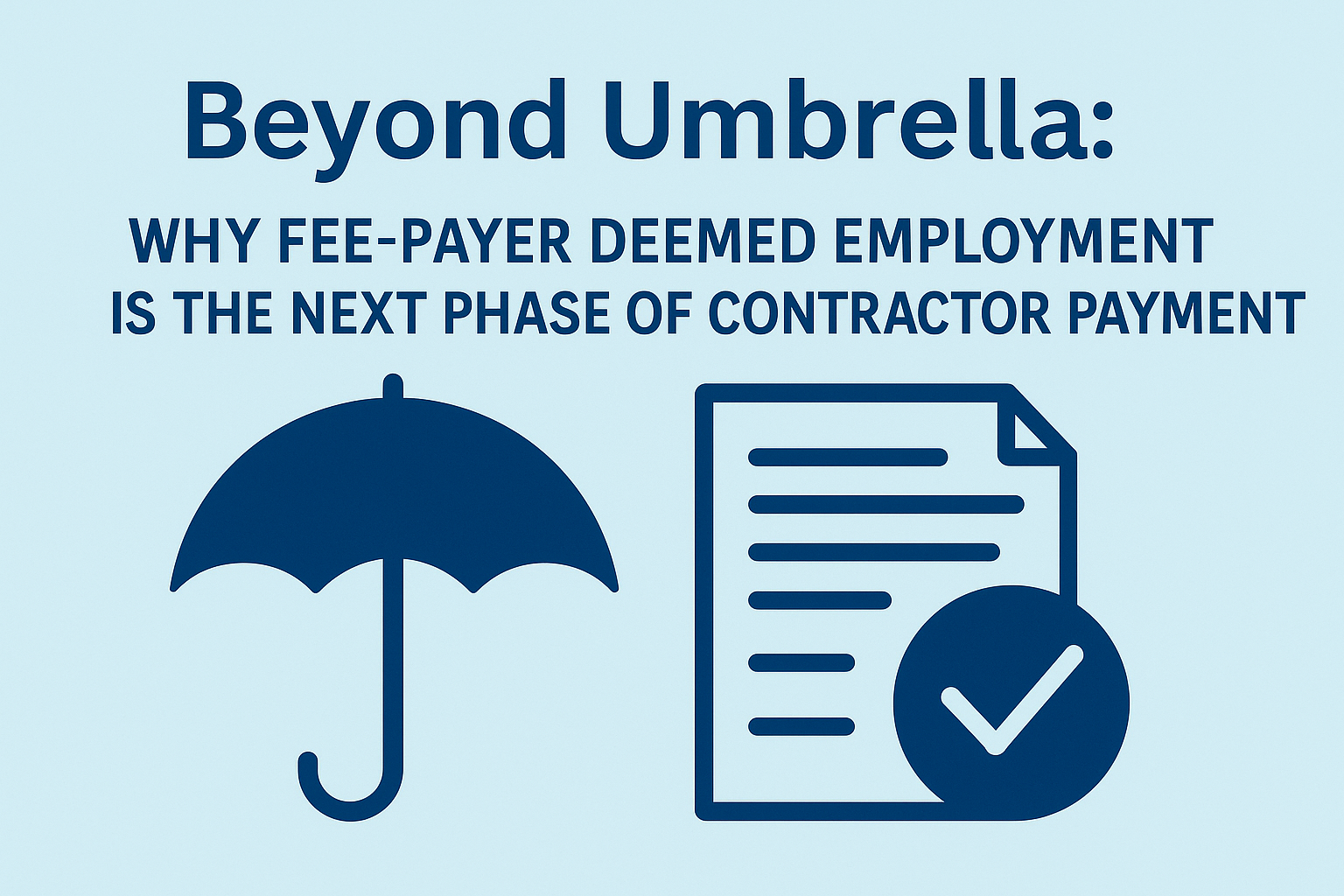When IR35 reforms reshaped the contracting landscape in 2021, umbrella companies became the go-to solution for agencies and end-clients panicked by the sudden shift in off-payroll responsibility. For a while, they offered a quick, mostly compliant route to retain contingent talent without breaching HMRC’s rules.
But as the dust settled, cracks began to show. With further regulation looming under Chapter 11 of the Finance Bill and new Joint and Several Liability (JSL) rules due in April 2026, the risk landscape is shifting once again. The conversation is no longer about “how to get contractors paid,” but “how to keep the entire supply chain compliant, transparent, and future-proof.”
That’s where the fee-payer deemed employment model comes in.
The Post-Umbrella Pressure: A System Under Scrutiny
Umbrella companies have served an important role in simplifying contractor engagement. They consolidate payroll, ensure PAYE deductions, and reduce administrative load for agencies. However, as the market matured, the ‘one-size-fits-all’ approach meant issues emerged: opaque pay models, inconsistent compliance standards, and complex sub-supply chains with unclear accountability. Perhaps most notable however, was the reaction of those higher paid, limited company users who, decided to leave the UK contracting market altogether.
The introduction of joint and several liability means agencies and end-clients could soon be held directly responsible for non-compliance anywhere in the chain. Even where an umbrella sits between them and the worker, risk now flows upstream.
As a result, recruiters and hiring organisations are looking beyond umbrella arrangements to models that deliver:
- Direct compliance visibility
- Streamlined governance
- Reduced exposure to third-party failings
Fee-Payer Deemed Employment: A Clearer Alternative
In a third-party fee-payer or deemed employment arrangement, the agency or client retains control over the SDS (Status Determination Statement), but a compliant partner, like Kimson, acts as the “fee payer” — calculating PAYE, NICs, and pension contributions directly.
Unlike an umbrella, which employs the worker under its own company, the fee payer operates transparently within the existing contractual chain under a Contract for Services, not a Contract of Employment.
Key distinctions:
| Area | Umbrella Model | Fee-Payer Deemed Employment |
|---|---|---|
| Employment relationship | Worker employed by umbrella | Worker remains engaged via the contractual chain (deemed employee) |
| Visibility of costs | Often blended margin | Fully transparent margin and deductions |
| Compliance exposure | Shared risk across multiple entities | Direct compliance oversight under one accountable fee payer |
| Governance | Varies by provider; accreditation-driven | Auditable, HMRC-aligned PAYE operation |
| Adaptability to future reforms | Dependent on umbrella regulation | Aligned to statutory IR35 framework, no legislative overhaul required |
In short, the fee-payer model through Kimson restores clarity and accountability to the engagement chain, giving agencies and clients control, without assuming the full operational burden of payroll.
Case in Point: Agencies Future-Proofing Now
Several mid-sized recruitment businesses have already transitioned portions of their contractor book to fee-payer models. Their motivation? Control and certainty.
One technology staffing agency reported that after adopting a third-party deemed employment solution:
- Contractor onboarding times fell by 28%
- Audit readiness improved, with full PAYE data visibility
- No margin discrepancies were found in annual reconciliations
Another engineering agency noted that their clients appreciated the clear chain of accountability, reducing concerns about shared liability when working with government and defence contracts.
Crucially, these agencies didn’t abandon umbrella models entirely, they segmented. Short-term, high-churn roles still route through compliant umbrella partners, while longer-term or higher-risk projects now sit under a fee-payer model.
This blended strategy maximises flexibility while tightening control.
How to Transition – and What to Watch For
Moving towards a fee-payer solution doesn’t have to mean overhauling your entire contingent workforce model overnight.
Here’s a structured approach:
- Map your supply chain
Identify all intermediaries between you and the worker. Visibility is key before liability can be managed.
- Segment your workforce
Determine which contractors (e.g. long-term, inside IR35, or client-critical) would benefit from direct deemed employment.
- Engage a compliant third-party fee payer
Choose a partner with demonstrable IR35 expertise, HMRC audit transparency, and a proven PAYE process. For example, Kimson don’t just organise the payroll element, they work in conjunction with the agency to attract incremental business and then to convert that in to successful candidates.
- Maintain umbrella relationships selectively
For low-risk or short-term engagements, continue working with trusted umbrellas. The goal is diversification, not displacement.
- Educate clients and contractors
Communicate how the model protects all parties, enhances transparency, and aligns with new legislation.
A Call to Action: Assess Your Supply Chain Now
April 2026 may seem distant, but the groundwork for compliance starts today.
Recruiters and end-clients who wait until the reforms take effect risk scrambling to restructure under pressure or worse, being caught in liability disputes stemming from others’ non-compliance.
The market is moving towards simplicity, transparency, and accountability.
Fee-payer deemed employment isn’t just another payroll option; it’s the logical evolution of contractor engagement in a regulated world.
Now is the time to look beyond umbrella and take control of your compliance destiny. Speak to Kimson and we’ll talk you through it.


